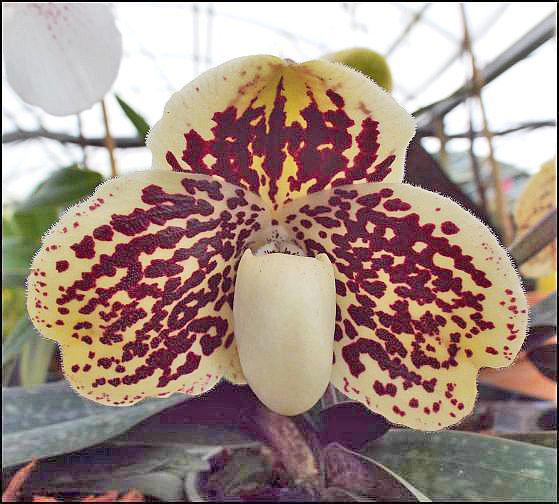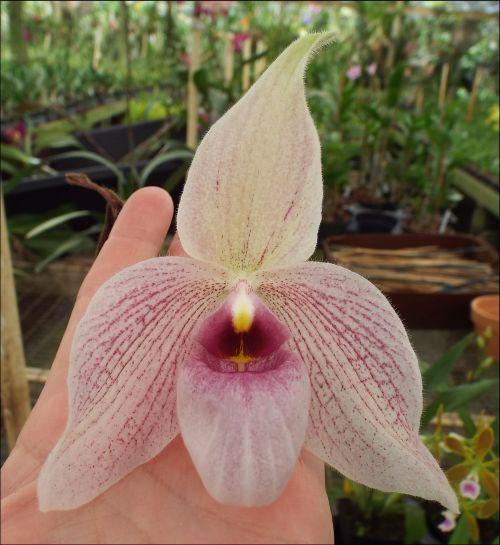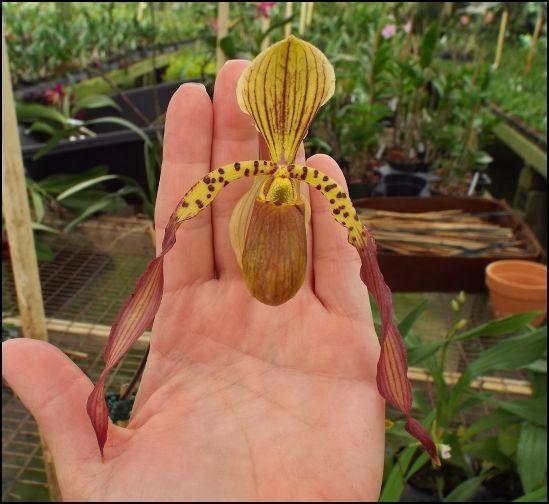The official Latin name of this group is Paphiopedilum. The common name is Asian Lady's Slipper,' but you'll probably hear them referred to as lady's slippers or just plain slipper orchids — though they're anything but plain. These orchids got their common name because of their pouch-like lip, or labellum, which resembles a lady's slipper.
I'd like introduce you to the world of lady's slipper orchids — giving you some slipper-specific growing tips, and some suggestions of varieties to buy.
Simple Growing Requirements
Although lady's slipper orchids are found in cold climates in North America, the ones that are most commonly grown indoors are the ones from the old-world tropics, like Southeast Asia. Almost all lady's slippers grow well in average home temperatures — 65 ° F to 75 ° F during the day, and 55 ° F to 60 ° F during the evening — and have modest humidity requirements.
Some of the lady's slippers are among the least demanding orchids when it comes to light, so they're very adaptable to growing in windowsills or under lights. You can grow them in an East-facing window, under florescent lights (I''ll give you more details on this later) and in a shaded greenhouse. They are great companions with Phalaenopsis.
Getting Your Slippers to Bloom
Slipper orchids are some of the easiest of all orchids to grow and bloom. That said, you can't force these plants to flower if they're not mature or if it isn't their normal time of year to bloom. If your slipper orchid hasn't bloomed in over a year, and it needs a little nudging, try this three-step method:
1. Grow your lady's slipper in a little brighter spot (see Chapter 5 for more details about orchid light needs). If you don't see the flower buds forming in six to eight weeks, keep it in this same location and move to Step 2.
2. Drop the temperature at night about 20 ° F cooler than the daytime temperature.
If you don't see buds forming in six to eight weeks, move it back to its regular growing temperature and then move to Step 3.
3. Let your lady's slipper get a little drier than usual for six to eight weeks.
Maudiaes Are the Easiest of the Easy to Grow and Flower
What a fabulous group of lady's slippers these are. The word Maudiae is the name given to the of the first hybrids made, in 1901, between Paphiopedilum callosum and Paphiopedilum lawrenceanum. Paphiopedilum Maudiae and its offspring are noted for their exceptional vigor, ease of blooming (sometimes more than once a year), undemanding growing requirements, gorgeous foliage, and striking, gloriously colored flowers. They are found in three major color groups or combinations, and are very economical to purchase..
Green-and-whites
Green-and-white Maudiaes are occasionally referred to as albinos because they lack the more commonly found red pigment. There is a simple timeless elegance to these flowers. They're highly revered in Europe as a cut flowers.

Coloratums
This group is typified by a large dorsal and petals displaying streaks of purple in the flowers. The flower shape of this type looks very similar to the green-and-white Maudiae but has much more red and burgundy markings . Many times the dorsal is larger and rounder.

Vinicolors
The flowers of this type look like they've been varnished. They're a rich dark red or purple and have many admirers. This is probably the most sought after form of the Maudiae types. Their solid burgundy to mahogany blossoms shine
Other Beautiful Slippers to Try
Lady's slipper species, which is what the plants are called as they come from the wild, display an exotic array of nature's work.
Here are a few gems:

Paph. leucochilum
Every one has room for this charming miniature slipper. It also has beautiful foliage.

Paphiopedilum liemianum
If you want a slipper orchid that keeps on blooming, try this one that is called a "sequential bloomer.
Primary Hybrids
Primary hybrids are the results of crossing (mating) two different species to create a new plant. In doing this, exciting new forms of orchids are created. The crossing process started in the 1800s and is continuing at full speed today. As new species are being discovered or better forms of the same species are showing up, the orchid breeder gets more new genetic material to play with. The results of some of these efforts are quite impressive.
The goals of breeding vary within the group, but the main purpose is to:
* Expand the color range.
* Vary the flower shapes.
* Make the flowers larger.
* Create a new "look."
* Make the plants more compact.
Here are few stunning primary hybrid paphiopedilums.
If you want a slipper with an aristocratic bearing , this Lynleigh Koopowitz fits the bill.

Paph. Lynleigh Koopowitz (delenatii x malipoense)
Or if you are after the exotic look of twisted, pendulous petals try Paph. Berenice.

Paph. Berenice (phillipinense x lowii)
This is just a sampling of the many fabulous slippers to try. For long lasting exotic flowers with gorgeous foliage that are very easy to grow, slipper orchids can't be beat.